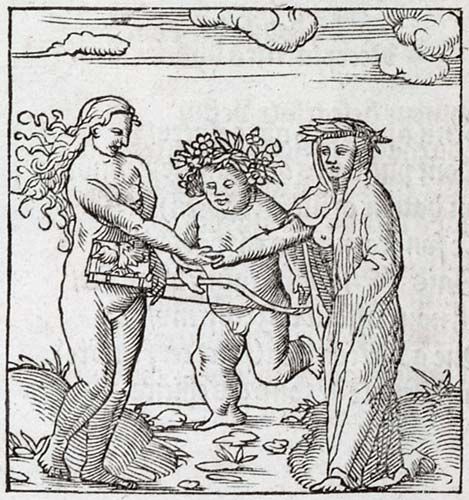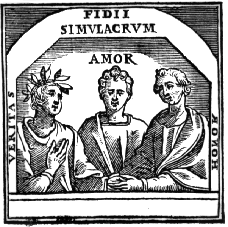RLG wrote:
I have to agree with all these points. Although we have many orders of the trumps, it does seem like everybody used the same set of images, which would indicate that they were all accepted by players, even if not understood as a sequence by people in every region. (this of course presumes that the earliest decks also had 22 non-suit cards, which is sort of hard to prove when the cards themselves, and accounts of them, don't exist).
It's true we don't have a precise description of the trumps before the Steele Sermon. The earliest evidence (Ferrara, February 10, 1442) describes
cartexelle da trionffy as having "coins, cups, swords, batons and all the figures". Doesn't describe the "figures".
I infer from the
extent of the game in the first decade, where the game is known by that name in Ferrara, Milan, Cremona, Florence, Siena, and likely Monselice, Pavia, and Bologna (at a minimum), that it was in a standard form which would preclude the addition of the identical subjects in the identical number in the decades afterward (as presumed by the 5x14 theory) by everybody equally. I think the different arrangements only strengthen that impression, since they are the same cards - again - but in different orders. Everybody got the same set of cards, unnumbered, around the same time, and ordered them a little differently (this insight of "different interpretations of the same image(s) by contemporaries" was the point of the quote from
World Politics I gave above).
Also important are the existence, barely attested but still there, of cheaper and less elegant packs than those of the courts. To have a game known by a generic name, you have to have a standard which everyone recognizes.
As for the order of the Papi, it does seem obvious that it is all a question of where to put the Papess. But oddly enough, of the three possible positions for her, the one that makes the least sense is the Tarot de Marseille order, unless the designer was following a triptych, 2-1, scheme. Then the only sensible place for the Papess would be in position three. So in my novice opinion, the role of the Papess is the key to understanding the first section of the trumps. And her position after the Bagatto is evidence for a triptych.
My own preferred explanation for the Popess and Empress is that they are inventions in the court of Milan (or maybe Ferrara). The most extravagant example of adding females to the pack is the Cary-Yale (Visconti di Modrone), but it is also evident in more standard luxury packs in the Chariot card (Cary-Yale, Visconti-Sforza, Issy Chariot (Ferrara)) for example.
I believe that the original form was two popes and two emperors (Bologna, invented for the academic/professional class), but this didn't suit courtly tastes - they wanted more poetic/romantic subjects, and included many more female characters.
I think her original meaning would have been "(The) Faith" (and the Empress "Empire"), and even in the courts in the earliest phase that these would have been played like in Bologna, where, in a trick where Papi are the only trumps played, the last played to the trick wins. This rule quickly died out in most places, and the cards became ordered and numbered, which caused the problem of placing the Popess.
I also agree that the position of World or Angel would not substantially change the meaning of the last section of the trumps. My guess is that it would depend on a person's interpretation of the Angel as Judgement. Is the 'Last' Judgement really the last thing to occur in the narrative? If one thinks of a Last Judgement being followed by a New Jerusalem, then probably the World card would be last, (in its early guise as a city). But if the World card is really Christ Pantocrator or Triumphant, then it would presumably be the final card, (although I guess you could argue that Christ appears and then dispenses the final Judgement). But either way, I think the difference is a subtle one that does not really disrupt the basic story of the last section of the trumps, although the radical change in the imagery of the World card is certainly worthy of debate.
My current view is that the A-Southern family is the original (as you have probably noticed), and that in this design the World represents the triumphant soul (triumphant over the world). As such, the only higher or later thing can be the bodily resurrection, shown in the last card.
I do think that the placement of the World as the highest card is a reference to the New World, including the New Jerusalem. I also recently learned that Savonarola explicitly tried to remake Florence into a model of the "New Jerusalem" (I guess in a Calvin-Geneva type way), which may help explain why the Minchiate packs depict Florence in the Fame (formerly Angel-Resurrection-Judgment) card.
As for the Sforza Castle - Tarot de Marseille style figure, I think it was originally a male in the laurel-wreath mandorla (laurel explicitly recalling the theme of "triumph"), but it morphed into a female (always a more attractive subject for male card-players).
On another note, you had posted a long segment on the relation of trumps to a gambling die, including a list of alphabetized vices. It would seem that the list of trumps following an alphabetic order would be the simplest possible explanation for there being 21 cards. Is there any evidence for this other than Filipas' abecedarium idea?
RLG
I can't find any alphabetic scheme in any list of trumps. If there is a connection between the alphabet, the points of a die (or throws of two die) and the trumps, my best guess is that is only in the number itself, as a symbol of fortune (and hence the game itself). There is no systematic correlation of a particular number to a particular card - just the whole number "21".
Ross



